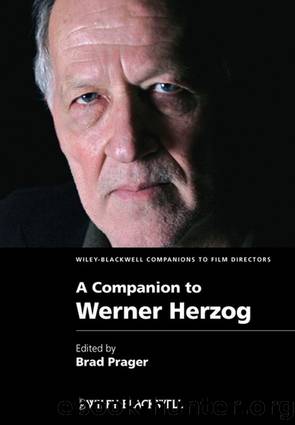A Companion to Werner Herzog by Prager Brad;

Author:Prager, Brad; [Prager, Brad;]
Language: eng
Format: epub
ISBN: 9781405194402
Publisher: Wiley
Published: 2012-03-10T06:00:00+00:00
Free Range Chicken
In devising a solution for his costume, however, Kinski exposes his character to another drama that included Herzog. The directorâs antipathy for chickens is well known. Of all animals they are the least welcome on Herzogâs ark. In Even Dwarfs Started Small (1970), images of one chicken cannibalizing another effectively serve as the movieâs clock, measuring the filmâs progress into anarchy. These are interspersed with images of a hobbling chicken tormented by his peers. Another recurring image is of a chicken darting right to left and back again, as if Herzog were suggesting that chickens, contrary to one popular figure of speech, run no differently with their heads on than cut off. Herzogâs hatred of this bird may be his one philosophically elaborated point. He has repeatedly said, âlook into the eyes of a chicken and you will see real stupidity. It is [â¦] bottomless stupidity, a fiendish stupidityâ (Cronin 2002: 99). The small eyes of this bird open up a sizable abyss for the director: this encounter betokens the only instance in which sublimity inspires in Herzog not wonder but a shudder, a response of fear (mixed with enmity and respect). An overlap exists between the fiendish stupidity of the chicken and Herzogâs âbest fiend,â Kinski, who has, Herzog says in another context, âbeen endowed with a fair share of natural stupidityâ (Cronin 2002: 293). This reserve of stupidity, a kind of stubbornness in which the absence of thought blurs with the independence of thinking, seems common to both bird and actor. To Herzog, stupidity has the resiliency of Odysseusâ wiliness, but in reverse gear. Stupidity is unpredictable, assumes forms that are equally (endlessly) surprising and disappointing. In short it is impossible to calculate, outwit, or govern. âYou canât legislate stupidityâ is one of Herzogâs lessons of darkness.5 In Signs of Life (1968) Herzog hypnotizes a chicken in order to test its ability to act (a kind of casting all for his subsequent film Heart of Glass [1976]). The hypnotized bird seems to sleep, plays dead; unconscious, it literally follows a straight line drawn on the ground (at odds with the poetry Herzog seeks from hypnotized actors). Kinski likewise obstructs hypnotic and, implicitly, directorial suggestion. The image riveted to Herzogâs memory, from Children, Mother, and the General (Laslo Benedek, 1955) shows Kinski waking up. Kinski lifts himself from the depths of sleep with a disorientation so internal that he seems to have difficulty recognizing where he is. Habitual actions (checking his watch, putting on his hat) slowly reattach the character to his brutal military duties. Herzog shows this scene three times in succession in My Best Fiend as part of his own coming-to-awareness of the multiplicity of signs and gestures by which Kinski evinces his return to waking life, even after waking. Kinskiâs signature moment is one in which he tumbles through the labyrinth of the waking process, setting him apart from the hypnotized actor who leaves his open-eyed sleep through a snap of the directorâs fingers.
Aguirre famously opens with two movements that transfix the viewer.
Download
This site does not store any files on its server. We only index and link to content provided by other sites. Please contact the content providers to delete copyright contents if any and email us, we'll remove relevant links or contents immediately.
| Dance | Individual Directors |
| Magic & Illusion | Reference |
| Theater |
Call Me by Your Name by André Aciman(20371)
Ready Player One by Cline Ernest(14524)
How to Be a Bawse: A Guide to Conquering Life by Lilly Singh(7391)
Wiseguy by Nicholas Pileggi(5671)
The Kite Runner by Khaled Hosseini(5083)
On Writing A Memoir of the Craft by Stephen King(4863)
Audition by Ryu Murakami(4850)
The Crown by Robert Lacey(4723)
Call me by your name by Andre Aciman(4619)
Gerald's Game by Stephen King(4581)
Harry Potter and the Cursed Child: The Journey by Harry Potter Theatrical Productions(4440)
Dialogue by Robert McKee(4321)
The Perils of Being Moderately Famous by Soha Ali Khan(4169)
Dynamic Alignment Through Imagery by Eric Franklin(4116)
Apollo 8 by Jeffrey Kluger(3637)
Seriously... I'm Kidding by Ellen DeGeneres(3577)
The Inner Game of Tennis by W. Timothy Gallwey(3575)
How to be Champion: My Autobiography by Sarah Millican(3555)
Darker by E L James(3477)
